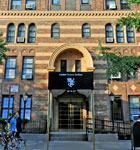The Prime Hotel at First and Ocean
Miami Beach, FL
Started
2005
Completed
2010
Size
10,000 square feet
Building Type
Lodging
When the Myles Restaurant Group approached Vitalini about designing a new three-story hotel smack dab in the middle of one of Miami’s historic districts, it was notable that the construction would be right next to the oldest surviving residential building in the city. VC Architects was prepared, though, because of its partners’ experience with and time in Western Europe, where “new” can means a structure that’s still around 150 years old.
“Because of our roots, we try to think about the future and how to give our designs a sense of permanence,” Vitalini says. “The Prime Hotel was very challenging because it [had to] fit right next to the Brown’s Hotel [built in 1915].”
The new building needed to be a high-energy, multicultural structure that would not overshadow the Brown’s Hotel’s history, and it had to do this while sitting atop a commercial block including restaurants and retail space. Inspired by the Art Deco and Modernist movements, VC Architects set out to do just that.

“Our approach had to be very delicate,” Vitalini says. “We decided to keep the design simple but play on the materials that would add to the individuality without being overbearing to the neighbors.”
The resulting structure is a white building with simple metal screens that have a homologous feel on the side closest to the Brown’s but that also take on a separate identity on the sides of the hotel more distant from its venerable neighbor. The balconies, with their horizontal glass panels, have touches of 1950s modernity mixed with the 21st century’s upgraded technology. And inside, a roof deck, stone details in the lobby, and hardwood floors complete the design.
But no building succeeds when it exists solely to blend in. With that in mind, VC Architects went to extra lengths to give the Prime Hotel its own highlights, including seamless integration into the streetscape below.

“The building is almost at the corner of Ocean Drive,” Vitalini says. “And the street experience is something that is very important in Miami. We aligned the entrances of the lower-level restaurant to actually be along the street.” The sweeping glass windows all the way up the building certainly enhance the effect, ensuring patrons on the inside are never—and never feel—too far away from the outside.
The balconies, too, emphasize indoor-outdoor connectivity with clear glimpses of the oceanfront. Looking down from a room, bright lights, bustling traffic, verdant palm trees, and sea breezes are the order of the evening.
“I think we managed to make [the Prime Hotel and its neighbors] work well together,” Vitalini says. “It’s a modern design, but it takes a lot of its cues from its surroundings.” ABQ


